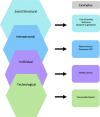Using social media listening to understand barriers to genomic medicine for those living with Ehlers-Danlos syndromes and hypermobility spectrum disorders
- PMID: 37062887
- PMCID: PMC10349242
- DOI: 10.1111/hex.13755
Using social media listening to understand barriers to genomic medicine for those living with Ehlers-Danlos syndromes and hypermobility spectrum disorders
Abstract
Introduction: Technological improvements alone have not led to the integration of genomic medicine across a broad range of diseases and populations. For genomic medicine to be successfully implemented across specialties and conditions, the challenges patients and caregivers experience need to be identified using a multi-faceted understanding of the context in which these obstacles occur and how they are experienced. Individuals affected by rare conditions, like Ehlers-Danlos syndromes (EDS) and hypermobility spectrum disorders (HSD), express numerous challenges with accessing genomic medicine. Many patients living with rare diseases seek information and find comfort in online health communities.
Methods: Social media conversations facilitated through online health communities are windows into patients' and caregivers' authentic experiences. To date, no other study has examined genomic medicine barriers by analysing the content of social media posts, yet the novel methodological approach of social media listening permits the analysis of virtual, organic conversations about lived experiences.
Results/conclusions: Using a modified social-ecological model, this study found that social-structural and interpersonal barriers most frequently impede access to genomic medicine for patients and caregivers living with EDS and HSD.
Patient or public contribution: Data were retrieved through social media conversations facilitated through publicly accessible health communities through Inspire, an online health community. Social media listening permits the analysis of virtual, organic conversations about lived experiences.
Keywords: Ehlers-Danlos syndromes; genomic medicine; health care access; hypermobility spectrum disorders; social media listening.
© 2023 The Authors. Health Expectations published by John Wiley & Sons Ltd.
Conflict of interest statement
Catherine Brownstein works at Boston Children's Hospital, and Sonja Ziniel works at Colorado Children's Hospital. Amanda Leigh Garrett, Erika Kline, Erica Payton, Kathleen Hoffman and Aleah Goldin are former or current employees of Inspire.
Figures
Similar articles
-
Patient experience of chronic illness care and complementary integrative health use: a cross-sectional study of patients with hypermobility spectrum disorders (HSD) and Ehlers-Danlos syndromes (EDS).Disabil Rehabil. 2023 Oct;45(21):3549-3559. doi: 10.1080/09638288.2022.2131003. Epub 2022 Oct 12. Disabil Rehabil. 2023. PMID: 36222285
-
Ehlers-Danlos Syndromes, Joint Hypermobility and Hypermobility Spectrum Disorders.Adv Exp Med Biol. 2021;1348:207-233. doi: 10.1007/978-3-030-80614-9_9. Adv Exp Med Biol. 2021. PMID: 34807421
-
Healthcare experiences among adults with hypermobile Ehlers-Danlos syndrome and hypermobility spectrum disorder in the United States.Disabil Rehabil. 2024 Feb;46(4):731-740. doi: 10.1080/09638288.2023.2176554. Epub 2023 Feb 11. Disabil Rehabil. 2024. PMID: 36772820
-
A review of respiratory manifestations and their management in Ehlers-Danlos syndromes and hypermobility spectrum disorders.Chron Respir Dis. 2021 Jan-Dec;18:14799731211025313. doi: 10.1177/14799731211025313. Chron Respir Dis. 2021. PMID: 34291699 Free PMC article. Review.
-
Neurodevelopmental atypisms in the context of joint hypermobility, hypermobility spectrum disorders, and Ehlers-Danlos syndromes.Am J Med Genet C Semin Med Genet. 2021 Dec;187(4):491-499. doi: 10.1002/ajmg.c.31946. Epub 2021 Nov 6. Am J Med Genet C Semin Med Genet. 2021. PMID: 34741402 Review.
Cited by
-
Sentiments of Individuals with Interstitial Cystitis/Bladder Pain Syndrome Toward Pentosan Polysulfate Sodium: Infodemiology Study.JMIR Form Res. 2025 Jan 17;9:e54209. doi: 10.2196/54209. JMIR Form Res. 2025. PMID: 39864816 Free PMC article.
-
Patient and care partner perspectives and preferences related to myasthenia gravis treatment: A qualitative study.Health Sci Rep. 2024 Sep 24;7(9):e70081. doi: 10.1002/hsr2.70081. eCollection 2024 Sep. Health Sci Rep. 2024. PMID: 39323457 Free PMC article.
-
Patient, Care Partner, and Physician Voices in Treatment Decision-Making for Multiple Myeloma.Patient Prefer Adherence. 2024 Oct 19;18:2147-2158. doi: 10.2147/PPA.S474722. eCollection 2024. Patient Prefer Adherence. 2024. PMID: 39445100 Free PMC article.
References
-
- United States Census Bureau . Health insurance coverage in the United States: 2020. 2021. Accessed May 4, 2022. http://www.census.gov/library/publications/2021/demo/p60-274.html
-
- Healthy People 2030 . Health care access and quality. 2022. Accessed May 4, 2022. https://health.gov/healthypeople/objectives-and-data/browse-objectives/h...
Publication types
MeSH terms
Grants and funding
LinkOut - more resources
Full Text Sources
Medical



